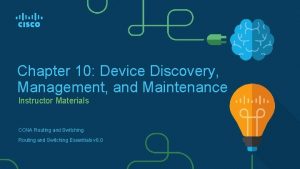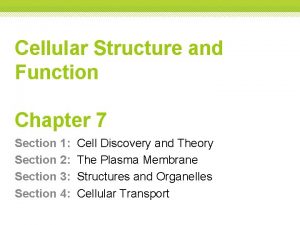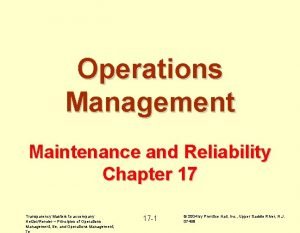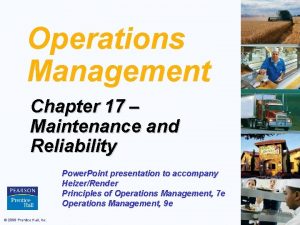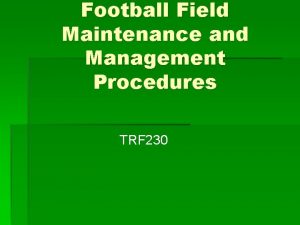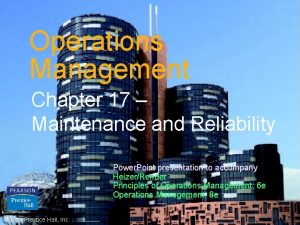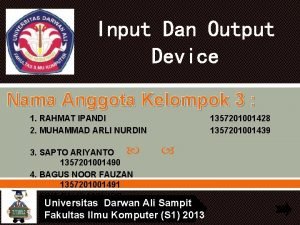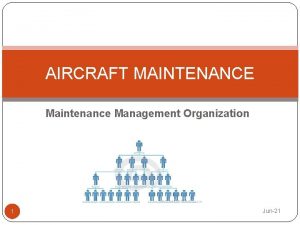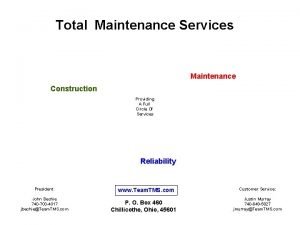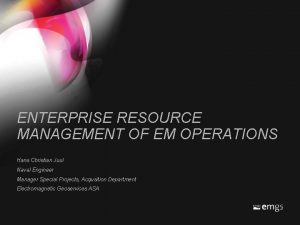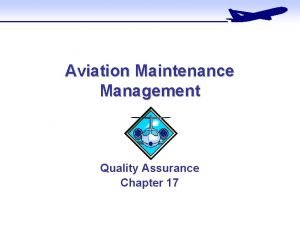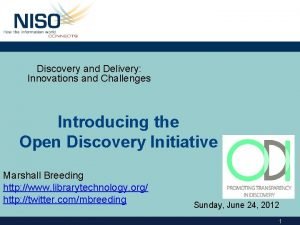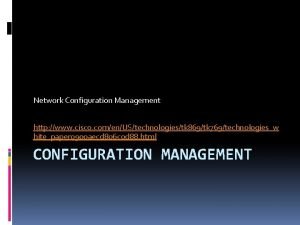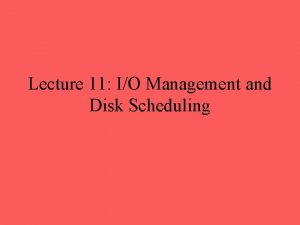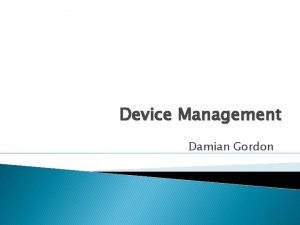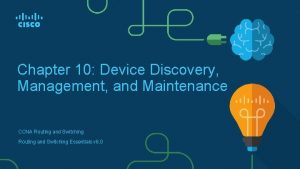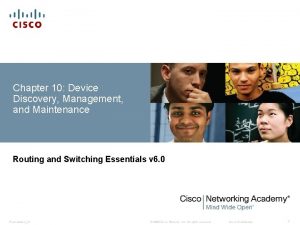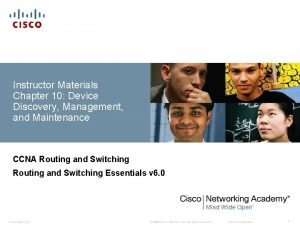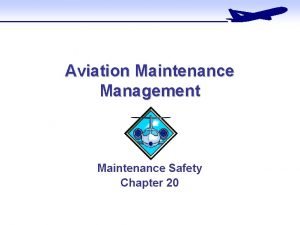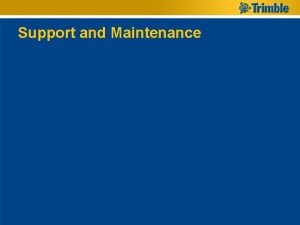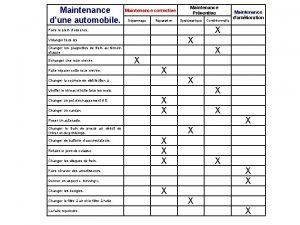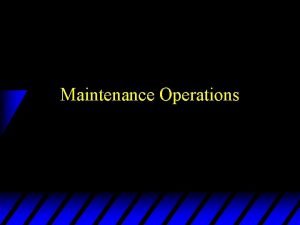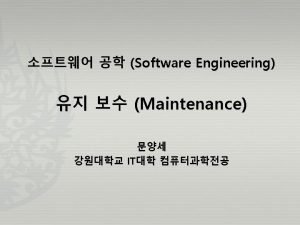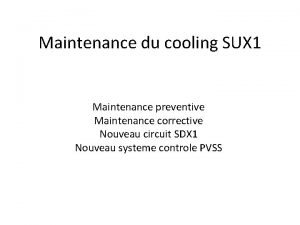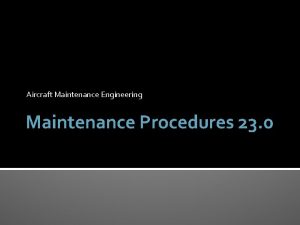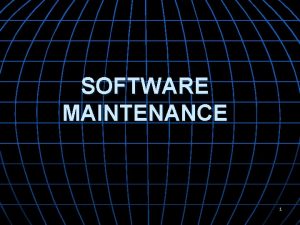Chapter 10 Device Discovery Management and Maintenance Instructor









































































- Slides: 73

Chapter 10: Device Discovery, Management, and Maintenance Instructor Materials CCNA Routing and Switching Essentials v 6. 0

Chapter 10: Device Discovery, Management, and Maintenance Routing and Switching Essentials 6. 0 Planning Guide © 2016 Cisco and/or its affiliates. All rights reserved. Cisco Confidential 3

Chapter 10: Device Discovery, Management, and Maintenance CCNA Routing and Switching Essentials v 6. 0

Chapter 10 - Sections & Objectives § 10. 1 Device Discovery • Use discovery protocols to map a network topology. • Use CDP to map a network topology. • Use LLDP to map a network topology. § 10. 2 Device Management • Configure NTP and Syslog in a small to medium-sized business network. • Implement NTP between a NTP client and NTP server. • Explain syslog operation. • Configure syslog servers and clients. © 2016 Cisco and/or its affiliates. All rights reserved. Cisco Confidential 13

Chapter 10 - Sections & Objectives (Cont. ) § 10. 3 Device Maintenance • Maintain router and switch configuration and IOS files. • Use commands to back up and restore an IOS configuration file. • Explain the IOS image naming conventions implemented by Cisco. • Upgrade an IOS system image. • Explain the licensing process for Cisco IOS software in a small- to medium-sized business network. • Configure a router to install an IOS software image license. © 2016 Cisco and/or its affiliates. All rights reserved. Cisco Confidential 14

10. 1 Device Discovery © 2016 Cisco and/or its affiliates. All rights reserved. Cisco Confidential 15

Device Discovery with CDP Overview § Cisco Discovery Protocol (CDP) • Cisco proprietary Layer 2 protocol used to gather information about Cisco devices sharing a link • Periodic CDP advertisements sent to connected devices • Share type of device discovered, name of devices, and number and type of interfaces • Determine information about neighboring devices to build a logical topology when documentation is missing © 2016 Cisco and/or its affiliates. All rights reserved. Cisco Confidential 16

Device Discovery with CDP Configure and Verify CDP No neighbors detected Verify status and display information Enables CDP on interface (no CDP enable disables) no cdp run globally disables (cdp run enables) Indicates the interfaces with CDP enabled © 2016 Cisco and/or its affiliates. All rights reserved. Cisco Confidential 17

Device Discovery with CDP Discover Devices Using CDP show cdp neighbors discovers: § S 1 (Device ID) § Gig 0/1 (local port identifier) § Fas 0/5 (remote port identified) show cdp neighbors detail command provides additional information: § S for switch (R for router) § IPv 4 address § WS-C 2960 (hardware platform) § IOS version © 2016 Cisco and/or its affiliates. All rights reserved. Cisco Confidential 18

Device Discovery with CDP Discover Devices Using CDP (Cont. ) § Other devices connected to S 1 can be § No more devices to discover! determined § S 2 is revealed in the output! © 2016 Cisco and/or its affiliates. All rights reserved. Cisco Confidential 19

Device Discovery with CDP Packet Tracer – Map a Network Using CDP © 2016 Cisco and/or its affiliates. All rights reserved. Cisco Confidential 20

Device Discovery with LLDP Overview § Link Layer Discovery Protocol • Vendor-neutral neighbor discovery similar to CDP • Works with routers, switches, and wireless LAN access points • Advertises its identity and capabilities to other devices and information from a connected Layer 2 device © 2016 Cisco and/or its affiliates. All rights reserved. Cisco Confidential 21

Device Discovery with LLDP Configure and Verify LLDP § lldp run enables globally § LLDP can be configured on separate interfaces, configured separately to transmit and receive § To disable LLDP globally – no lldp run © 2016 Cisco and/or its affiliates. All rights reserved. Cisco Confidential 22

Device Discovery with LLDP Discover Devices Using LLDP © 2016 Cisco and/or its affiliates. All rights reserved. Cisco Confidential 23

Device Discovery with LLDP Lab – Configure CDP and LLDP © 2016 Cisco and/or its affiliates. All rights reserved. Cisco Confidential 24

10. 2 Device Management © 2016 Cisco and/or its affiliates. All rights reserved. Cisco Confidential 25

NTP Setting the System Clock Managing, securing, troubleshooting, and planning networks requires accurate timestamping Date and time settings on a router or switch can be set using one of two methods: § Manually configure the date and time, as shown in the figure § Configure the Network Time Protocol (NTP) § NTP uses UDP port 123 § NTP clients obtain time and date from a single source © 2016 Cisco and/or its affiliates. All rights reserved. Cisco Confidential 26

NTP Operation § Stratum 0 – top level of hierarchical system, authoritative time sources, assumed to be accurate § Stratum 1 – directly connected to authoritative sources and act as primary network time standard § Stratum 2 and Lower – connected to stratum 1 devices via network connections, act as servers for stratum 3 devices § Smaller stratum numbers closer to authoritative time source § Larger the stratum number, the lower the stratum level (max hop is 15) § Stratum 16, lowest stratum level, indicates device is unsynchronized © 2016 Cisco and/or its affiliates. All rights reserved. Cisco Confidential 27

NTP Configure and Verify NTP § Configure Stratum 2 NTP Server § Verify NTP Server Configuration § R 1 is synchronized with a stratum 1 NTP server at 209. 165. 200. 225 which is synchronized with a GPS clock © 2016 Cisco and/or its affiliates. All rights reserved. Cisco Confidential 28

NTP Configure and Verify NTP (Cont. ) § Configure Stratum 3 NTP Server § R 1 is a stratum 2 device and NTP server to S 1 § S 1 is a stratum 3 device that can provide NTP service to end devices © 2016 Cisco and/or its affiliates. All rights reserved. Cisco Confidential 29

NTP Packet Tracer - Configure and Verify NTP © 2016 Cisco and/or its affiliates. All rights reserved. Cisco Confidential 30

Syslog Operation Introduction to Syslog § Syslog • Describes a standard and protocol • Uses UDP port 514 • Send event notification messages across IP networks to event message collectors • Routers, switches, servers, firewalls support syslog § Syslog logging service provides three primary functions: • Ability to gather logging information for monitoring and troubleshooting • Ability to select the type of logging information that is captured • Ability to specify the destinations of captured syslog messages © 2016 Cisco and/or its affiliates. All rights reserved. Cisco Confidential 31

Syslog Operation § Syslog protocol starts by sending system messages and debug output to a local logging process internal to the device. § How the logging process manages these messages and outputs is based on device configurations. § Syslog messages may be sent across the network to an external syslog server. Can be pulled into various reports. § Syslog messages may be sent to an internal buffer. Only viewable through the CLI of the device. § Destinations for syslog messages include: • Logging buffer (RAM inside a router or switch) • Console line • Terminal line • Syslog server © 2016 Cisco and/or its affiliates. All rights reserved. Cisco Confidential 32

Syslog Operation Syslog Message Format § Cisco devices produce syslog messages as a result of network events § Every syslog message contains a severity level and a facility. • Smaller are more critical © 2016 Cisco and/or its affiliates. All rights reserved. Cisco Confidential 33

Syslog Operation Syslog Message Format (Cont. ) § Each syslog level has its own meaning: • Warning Level 4 - Emergency Level 0: Error messages about software or hardware malfunctions; functionality of the device is affected. • Notification Level 5: The notifications level is for normal events. Interface up or down transitions, and system restart messages are displayed at the notifications level. • Informational Level 6: A normal information message that does not affect device functionality. For example, when a Cisco device is booting, you might see the following informational message: %LICENSE-6 -EULA_ACCEPT_ALL: The Right to Use End User License Agreement is accepted. • Debugging Level 7: This level indicates that the messages are output generated from issuing various debug commands. © 2016 Cisco and/or its affiliates. All rights reserved. Cisco Confidential 34

Syslog Operation Syslog Message Format (Cont. ) § By default, the format of syslog messages on the Cisco IOS Software is: § Sample output on a Cisco switch for an Ether. Channel link changing state to up is: § Facility is LINK and the severity level is 3, with a MNEMONIC of UPDOWN. © 2016 Cisco and/or its affiliates. All rights reserved. Cisco Confidential 35

Syslog Operation Service Timestamp § By default, log messages are not timestamped § Log messages should be timestamped so when sent to destination (syslog server) there is a record of when the message was generated § Notice date below once timestamp is activated © 2016 Cisco and/or its affiliates. All rights reserved. Cisco Confidential 36

Syslog Configuration Syslog Server § To view syslog messages, a syslog server must be installed on a networked PC © 2016 Cisco and/or its affiliates. All rights reserved. Cisco Confidential 37

Syslog Configuration Default Logging § By default, log messages sent to the console. § Some IOS versions buffer log messages by default too. § First highlighted line states that this router logs to the console and includes debug messages. • all debug level messages, as well as any lower level messages are logged to the console § Second highlighted line states that this router logs to an internal buffer. § System messages that have been logged are at the end of the output. © 2016 Cisco and/or its affiliates. All rights reserved. Cisco Confidential 38

Syslog Configuration Router and Switch Commands for Syslog Clients § R 1 is configured to send log messages of levels 4 and lower to the syslog server at 192. 168. 1. 3 § Source interface is set as the G 0/0 interface § Loopback interface is created, then shut down, and then brought back up § Console output reflects these actions © 2016 Cisco and/or its affiliates. All rights reserved. Cisco Confidential 39

Syslog Configuration Verifying Syslog © 2016 Cisco and/or its affiliates. All rights reserved. Cisco Confidential 40

Syslog Configuration Packet Tracer – Configuring Syslog and NTP © 2016 Cisco and/or its affiliates. All rights reserved. Cisco Confidential 41

Syslog Configuration Lab – Configuring Syslog and NTP © 2016 Cisco and/or its affiliates. All rights reserved. Cisco Confidential 42

10. 3 Device Maintenance © 2016 Cisco and/or its affiliates. All rights reserved. Cisco Confidential 43

Router and Switch File Maintenance Router File Systems § show file systems lists all the available file systems § Provides information such as memory, type of file system, and permissions (read only (ro), read and write (rw)) § Interested in tftp, flash, and nvram file systems § Bootable IOS is located in flash so has a * © 2016 Cisco and/or its affiliates. All rights reserved. Cisco Confidential 44

Router and Switch File Maintenance Router File Systems (Cont. ) § To view the contents of NVRAM, change the § dir lists the contents of flash § Last listing is the name of the current Cisco IOS file that is running in RAM current default file system using the cd (change directory) command § pwd (present working directory) command verifies that we are viewing the NVRAM directory § dir lists the contents of NVRAM, included is the startup-configuration file © 2016 Cisco and/or its affiliates. All rights reserved. Cisco Confidential 45

Router and Switch File Maintenance Switch File Systems Command is same as with the router! © 2016 Cisco and/or its affiliates. All rights reserved. Cisco Confidential 46

Router and Switch File Maintenance Backing up and Restoring using Text Files 1. On the File menu, click Log. 2. Choose the location to save the file. Tera Term will begin capturing text. 3. After capture has been started, execute the show running-config or show startup-config command at the privileged EXEC prompt. Text displayed in the terminal window will be directed to the chosen file. 4. When the capture is complete, select Close in the Tera Term Log window. 5. View the file to verify that it was not corrupted. © 2016 Cisco and/or its affiliates. All rights reserved. Cisco Confidential 47

Router and Switch File Maintenance Backing up and Restoring using Text Files (Cont. ) Restoring Text Configurations § A configuration can be copied from a file to a device. § When copied from a text file and pasted into a terminal window, the IOS executes each line of the configuration text as a command. § At the CLI, the device must be set at the global configuration mode to receive the commands from the text file being pasted into the terminal window. When using Tera Term, the steps are: § Step 1. On the File menu, click Send file. § Step 2. Locate the file to be copied into the device and click Open. § Step 3. Tera Term will paste the file into the device. § Note: The text in the file will be applied as commands in the CLI and become the running configuration on the device. © 2016 Cisco and/or its affiliates. All rights reserved. Cisco Confidential 48

Router and Switch File Maintenance Backing up and Restoring using TFTP § Configuration files should be backed up and included in network documentation § Commands - copy running-config tftp (see figure) or copy startup-config tftp § To restore the running configuration or the startup configuration from a TFTP server, use copy tftp running-config or copy tftp startup-config command © 2016 Cisco and/or its affiliates. All rights reserved. Cisco Confidential 49

Router and Switch File Maintenance Using USB Ports on a Cisco Router § Certain models of Cisco routers support USB flash drives. § USB can be used for storage and booting. § USB flash can hold multiple copies of the Cisco IOS and multiple router configurations. § Use the dir command to view the contents of the USB flash drive. © 2016 Cisco and/or its affiliates. All rights reserved. Cisco Confidential 50

Router and Switch File Maintenance Backing up and Restoring Using USB • show file systems verifies USB drive and name © 2016 Cisco and/or its affiliates. All rights reserved. Cisco Confidential 51

Router and Switch File Maintenance Backing up and Restoring Using USB (Cont. ) § copy run usbflash 0: / command copies the running-config file to the USB flash drive (slash is optional but indicates the root directory of the USB flash drive) § IOS will prompt for the filename § If the file already exists on the USB flash drive, the router will prompt to overwrite © 2016 Cisco and/or its affiliates. All rights reserved. Cisco Confidential 52

Router and Switch File Maintenance Backing up and Restoring Using USB (Cont. ) § Use the dir command to see the file on the USB drive § Use the more command to see the contents § Use copy usbflash 0: /R 1 -Config running-config to restore running config © 2016 Cisco and/or its affiliates. All rights reserved. Cisco Confidential 53

Router and Switch File Maintenance Password Recovery Step 1. Enter the ROMMON mode. § With console access, a user can access the ROMMON mode by using a break sequence during the boot up process or removing the external flash memory when the device is powered off. Step 2. Change the configuration register to 0 x 2142 to ignore the startup config file. § Use the confreg 0 x 2142 command § Type reset at the prompt to restart the device Step 3. Make necessary changes to the original startup config file. § Copy the startup config to the running config § Configure all necessary passwords § Change the configuration register back to 0 X 2102 Step 4. Save the new configuration. © 2016 Cisco and/or its affiliates. All rights reserved. Cisco Confidential 54

Router and Switch File Maintenance Packet Tracer – Backing Up Configuration Files © 2016 Cisco and/or its affiliates. All rights reserved. Cisco Confidential 55

Router and Switch File Maintenance Lab – Managing Router Configuration Files with Tera Term © 2016 Cisco and/or its affiliates. All rights reserved. Cisco Confidential 56

Router and Switch File Maintenance Lab – Managing Device Configuration Files Using TFTP, Flash, and USB © 2016 Cisco and/or its affiliates. All rights reserved. Cisco Confidential 57

Router and Switch File Maintenance Lab – Researching Password Recovery Procedures © 2016 Cisco and/or its affiliates. All rights reserved. Cisco Confidential 58

IOS System Files IOS 15 System Image Packaging § G 2 router is shipped with a single universal Cisco IOS and a license is used to enable the specific feature set packages. § Each router ships with one of two types of universal images in ISR G 2: • “universalk 9" – offers all of the Cisco IOS software features, including strong payload cryptography features, such as IPsec VPN, SSL VPN, and Secure Unified Communications • “universalk 9_npe” – some countries have import requirements that require that the platform does not support any strong cryptography functionality, this image does not support any strong payload encryption § Features are activated through licensing. § Other technology packages enabled using Cisco Software Activation licensing keys. © 2016 Cisco and/or its affiliates. All rights reserved. Cisco Confidential 59

IOS System Files IOS Image Filenames Displays the files stored in flash memory § The most common designation for memory location and compression format is mz. The first letter indicates the location where the image is executed on the router. The locations can include: § f - flash § m - RAM § r - ROM § l - relocatable © 2016 Cisco and/or its affiliates. All rights reserved. Cisco Confidential 60 § The compression format can be z for zip or x for mzip.

IOS Image Management TFTP Servers as a Backup Location § Cisco IOS Software images and configuration files can be stored on a central TFTP server. § It is good practice to keep a backup copy of the Cisco IOS Software image in case the system image in the router becomes corrupted or accidentally erased. § Using a network TFTP server allows image and configuration uploads and downloads over the network. The network TFTP server can be another router, a workstation, or a host system. © 2016 Cisco and/or its affiliates. All rights reserved. Cisco Confidential 61

IOS Image Management Steps to Backup IOS Image to TFTP Server § The network administrator wants to create a backup of the current image file on the router (c 1900 universalk 9 -mz. SPA. 152 -4. M 3. bin) to the TFTP server at 172. 16. 1. 100. © 2016 Cisco and/or its affiliates. All rights reserved. Cisco Confidential 62

IOS Image Management Steps to Backup IOS Image to TFTP Server (Cont. ) © 2016 Cisco and/or its affiliates. All rights reserved. Cisco Confidential 63

IOS Image Management Steps to Copy an IOS Image to a Device • A new image file (c 1900 -universalk 9 mz. SPA. 152 -4. M 3. bin) will be copied from the TFTP server at 2001: DB 8: CAFE: 100: : 99 to the router. © 2016 Cisco and/or its affiliates. All rights reserved. Cisco Confidential 64

IOS Image Management Steps to Copy an IOS Image to a Device (Cont. ) © 2016 Cisco and/or its affiliates. All rights reserved. Cisco Confidential 65

IOS Image Management The boot system Command § To upgrade to the copied IOS image after that image is saved on the router's flash memory, configure the router to load the new image during boot up using the boot system command. § To verify the new image has loaded, use the show version command. § Several boot system commands can be entered to provide a faulttolerant boot plan. § If there is no boot system commands, the router defaults to loading the first valid Cisco IOS image in flash memory. © 2016 Cisco and/or its affiliates. All rights reserved. Cisco Confidential 66

IOS Image Management Packet Tracer - Using a TFTP Server to Upgrade a Cisco IOS Image © 2016 Cisco and/or its affiliates. All rights reserved. Cisco Confidential 67

IOS Image Management Video Demonstration - Managing Cisco IOS Images Objective: § Use a TFTP server to upload an updated IOS image file to a Cisco Router. § Use the boot system command to boot the router to the new IOS image file. § Reload the router and successfully boot to the new IOS image file. © 2016 Cisco and/or its affiliates. All rights reserved. Cisco Confidential 68

Software Licensing Overview § Each device ships with the same universal image. § Technology packages are enabled in the universal image via Cisco Software Activation licensing keys. § The Cisco IOS Software Activation feature allows the user to enable licensed features and register licenses. § Technology packages that are available: § IP Base § Data § Unified Communications (UC) § Security (SEC) © 2016 Cisco and/or its affiliates. All rights reserved. Cisco Confidential 69

Software Licensing Process • The figure shows the three steps to permanently activate a new software package or feature on a router. • PAK – Product Activation Key • UDI – Unique Device Identifier © 2016 Cisco and/or its affiliates. All rights reserved. Cisco Confidential 70

Software Licensing Step 1. Purchase the Software Package or Feature to Install § Customers receive a PAK with purchase that serves as a receipt and is used to obtain a license. § A PAK is an 11 digit alpha numeric key created by Cisco manufacturing. It defines the Feature Set associated with the PAK. § As shown in the figure, a separate license is required for each package, IP Base, Data, UC, and SEC. © 2016 Cisco and/or its affiliates. All rights reserved. Cisco Confidential 71

Software Licensing Step 2. Obtain a License § The UDI is a combination of the Product ID (PID), the Serial Number (SN), and the hardware version. The SN is an 11 digit number which uniquely identifies a device. The PID identifies the type of device. Only the PID and SN are used for license creation. § This UDI can be displayed using the show license udi command shown. © 2016 Cisco and/or its affiliates. All rights reserved. Cisco Confidential 72

Software Licensing Step 3. Install the License § A permanent license is a license that never expires. After a permanent license is installed on a router, it is good for that particular feature set for the life of the router, even across IOS versions. © 2016 Cisco and/or its affiliates. All rights reserved. Cisco Confidential 73

License Verification and Management License Verification © 2016 Cisco and/or its affiliates. All rights reserved. Cisco Confidential 74

License Verification and Management Activate an Evaluation Right-To-Use License © 2016 Cisco and/or its affiliates. All rights reserved. Cisco Confidential 75

License Verification and Management Back up the License § The license save command is used to copy all licenses in a device and store them. § Saved licenses are restored by using the license install command. § The command to back up a copy of the licenses on a device is: § Router# license save file-sys: //lic-location § Use the show flash 0: command to verify that the licenses have been saved. © 2016 Cisco and/or its affiliates. All rights reserved. Cisco Confidential 76

License Verification and Management Uninstall the License § Only licenses that have been added by using the license install command are removed. © 2016 Cisco and/or its affiliates. All rights reserved. Cisco Confidential 77

License Verification and Management Video Demonstration - Working with IOS 15 Image Licenses Objective • Identify the additional licensing types of Cisco ISR-G 2 routers • Identify the differences between permanent licensing and evaluation right-to-use licensing • Activate the security technology package on a Cisco 1941 router • Accept the end user license agreement • Verify the securityk 9 license and save it to flash memory © 2016 Cisco and/or its affiliates. All rights reserved. Cisco Confidential 78

10. 4 Chapter Summary © 2016 Cisco and/or its affiliates. All rights reserved. Cisco Confidential 79

Conclusion Packet Tracer – Skills Integration Challenge © 2016 Cisco and/or its affiliates. All rights reserved. Cisco Confidential 80

Conclusion Chapter 10: Device Discovery, Management, and Maintenance § Use discovery protocols to map a network topology. § Configure NTP and Syslog in a small to medium-sized business network. § Maintain router and switch configuration and IOS files. © 2016 Cisco and/or its affiliates. All rights reserved. Cisco Confidential 81

 Device discovery management and maintenance
Device discovery management and maintenance Cpu output device
Cpu output device Ac 61-98 plan of action
Ac 61-98 plan of action Virtual instructor art
Virtual instructor art Chapter 7 section 1 cell discovery and theory
Chapter 7 section 1 cell discovery and theory Chapter 7 section 1 cell discovery and theory
Chapter 7 section 1 cell discovery and theory Maintenance function
Maintenance function Maintenance cost example
Maintenance cost example Premier asset management llc
Premier asset management llc Trf football
Trf football What is reliability in operations management
What is reliability in operations management A tagout device is preferable to using a lockout device.
A tagout device is preferable to using a lockout device. Kelompok output
Kelompok output Tipología de los participantes
Tipología de los participantes Tcole instructor course
Tcole instructor course Basic instructor course texas
Basic instructor course texas Basic instructor course #1014
Basic instructor course #1014 Pepperball hotshot
Pepperball hotshot Subject verb agreement exercise
Subject verb agreement exercise Instructor vs teacher
Instructor vs teacher Ospfv
Ospfv Mptc firearms instructor
Mptc firearms instructor Basic instructor course texas
Basic instructor course texas Basic instructor course texas
Basic instructor course texas Nfpa 1403 instructor to student ratio
Nfpa 1403 instructor to student ratio Tp 12863
Tp 12863 Instructor operating station
Instructor operating station Catia instructor
Catia instructor Instructor
Instructor Tcole 1014 basic instructor course
Tcole 1014 basic instructor course Njrotc instructor vacancies
Njrotc instructor vacancies How to become an nrp instructor mentor
How to become an nrp instructor mentor Cisco instructor certification
Cisco instructor certification Cbrf wisconsin registry
Cbrf wisconsin registry Nra certified instructor logo
Nra certified instructor logo Naismith was an instructor of
Naismith was an instructor of If your instructor were to ask if you cleaned up your room
If your instructor were to ask if you cleaned up your room Tcole advanced instructor course
Tcole advanced instructor course Tcole advanced instructor course
Tcole advanced instructor course Jrotc marksmanship instructor course online
Jrotc marksmanship instructor course online エイムズの部屋
エイムズの部屋 Calcaneum plural
Calcaneum plural Basic instructor course #1014
Basic instructor course #1014 Basic instructor course tcole
Basic instructor course tcole Delmar cengage learning instructor resources
Delmar cengage learning instructor resources Instructor office hours
Instructor office hours Chapter 9 vehicle maintenance
Chapter 9 vehicle maintenance The discovery of ignorance chapter 14
The discovery of ignorance chapter 14 Fleet maintenance management system best practices
Fleet maintenance management system best practices World class maintenance management
World class maintenance management Total maintenance group
Total maintenance group Maintenance and engineering organizational chart
Maintenance and engineering organizational chart Total maintenance services
Total maintenance services Financial management in maintenance
Financial management in maintenance Management de la maintenance
Management de la maintenance Aircraft quality assurance
Aircraft quality assurance Maintenance of records and reports
Maintenance of records and reports Discovery and action dialogue
Discovery and action dialogue Information discovery and delivery
Information discovery and delivery Introduction to data mining and knowledge discovery
Introduction to data mining and knowledge discovery Exploration and discovery where ideas come from
Exploration and discovery where ideas come from Section 1 cell discovery and theory
Section 1 cell discovery and theory Kondratieff cycles geography
Kondratieff cycles geography Difference between invention and discovery
Difference between invention and discovery Pros and cons of discovery learning
Pros and cons of discovery learning Price discovery and price determination
Price discovery and price determination Section 1 cell discovery and theory
Section 1 cell discovery and theory Top management and middle management
Top management and middle management Top management middle management first line management
Top management middle management first line management Top level management
Top level management Mobile device management meraki
Mobile device management meraki I/o device management in operating system
I/o device management in operating system Cisco configuration management
Cisco configuration management I/o device management in operating system
I/o device management in operating system
